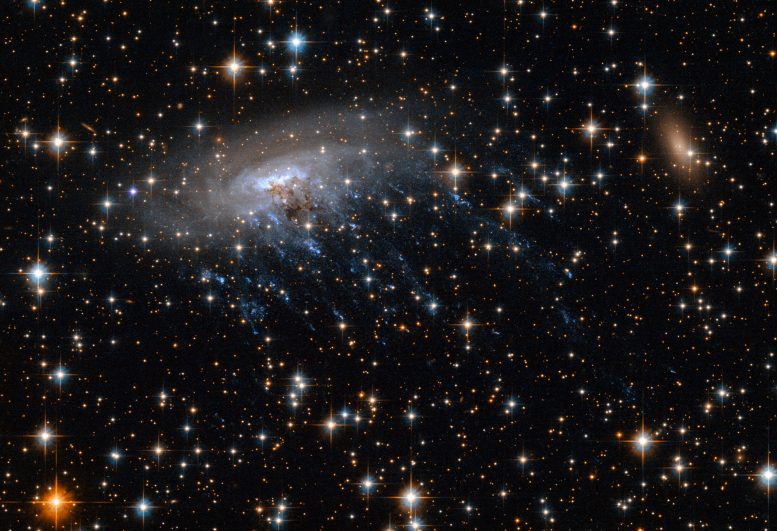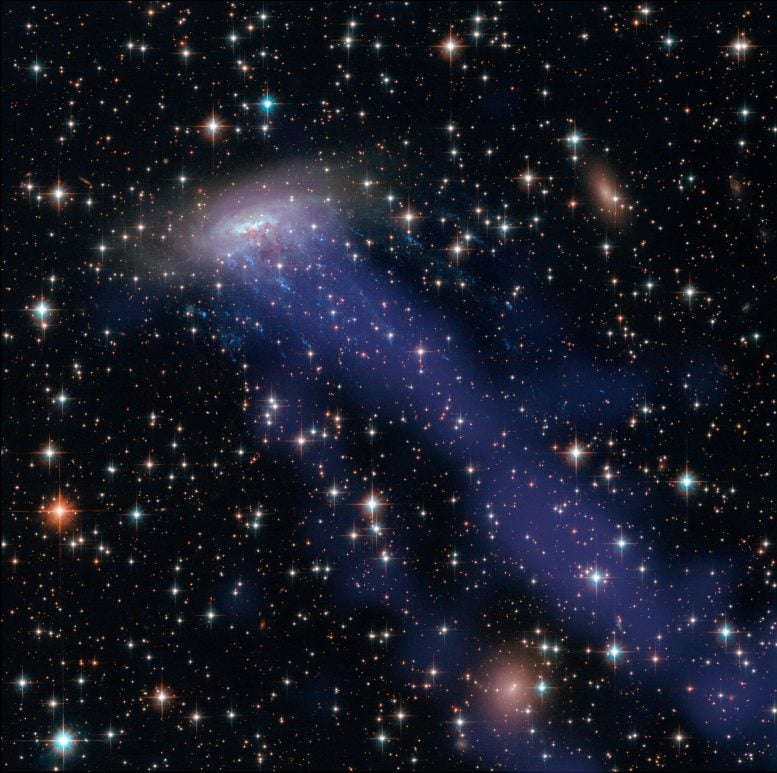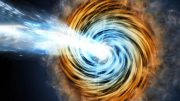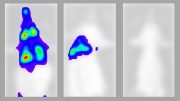
This new Hubble image shows spiral galaxy ESO 137-001, framed against a bright background as it moves through the heart of galaxy cluster Abell 3627. This image not only captures the galaxy and its backdrop in stunning detail, but also something more dramatic — intense blue streaks streaming outwards from the galaxy, seen shining brightly in ultraviolet light. These streaks are in fact hot, wispy streams of gas that are being torn away from the galaxy by its surroundings as it moves through space. This violent galactic disrobing is due to a process known as ram pressure stripping — a drag force felt by an object moving through a fluid. Credit: NASA, ESA; NASA, ESA, CXC
This newly released image from the Hubble Space Telescope shows spiral galaxy ESO 137-001.
The spiral galaxy ESO 137-001 looks like a dandelion caught in a breeze in this new Hubble Space Telescope image.
The galaxy is zooming toward the upper right of this image, in between other galaxies in the Norma cluster located over 200 million light-years away. The road is harsh: intergalactic gas in the Norma cluster is sparse, but so hot at 180 million degrees Fahrenheit that it glows in X-rays.
The spiral plows through the seething intra-cluster gas so rapidly – at nearly 4.5 million miles (7.2 million kilometers) per hour — that much of its own gas is caught and torn away. Astronomers call this “ram pressure stripping.” The galaxy’s stars remain intact due to the binding force of their gravity.
Tattered threads of gas, the blue jellyfish-tendrils trailing ESO 137-001 in the image, illustrate the process. Ram pressure has strung this gas away from its home in the spiral galaxy and out over intergalactic space. Once there, these strips of gas have erupted with young, massive stars, which are pumping out light in vivid blues and ultraviolet.
The brown, smoky region near the center of the spiral is being pushed in a similar manner, although in this case, it is small dust particles, and not gas, that are being dragged backward by the intra-cluster medium.
From a star-forming perspective, ESO 137-001 really is spreading its seeds into space like a dandelion in the wind. The stripped gas is now forming stars. However, the galaxy, drained of its own star-forming fuel, will have trouble making stars in the future. Through studying this runaway spiral, and other galaxies like it, astronomers hope to gain a better understanding of how galaxies form stars and evolve over time.
The image, obtained through Hubble’s Wide Field Camera 3, is also decorated with hundreds of stars from within our own Milky Way galaxy. Though not connected in the slightest to ESO 137-001, these stars and the two reddish elliptical galaxies contribute to a vibrant celestial vista.

This image combines NASA/ESA Hubble Space Telescope observations with data from the Chandra X-ray Observatory. As well as the electric blue ram pressure stripping streaks seen emanating from ESO 137-001, a giant gas stream can be seen extending towards the bottom of the frame, only visible in the X-ray part of the spectrum. Credit: NASA, ESA; NASA, ESA, CXC
The Hubble Space Telescope is a project of international cooperation between NASA and the European Space Agency. NASA’s Goddard Space Flight Center in Greenbelt, Maryland, manages the telescope. The Space Telescope Science Institute (STScI) in Baltimore conducts Hubble science operations. STScI is operated for NASA by the Association of Universities for Research in Astronomy, Inc., in Washington.









Be the first to comment on "Hubble Views Spiral Galaxy ESO 137-001"